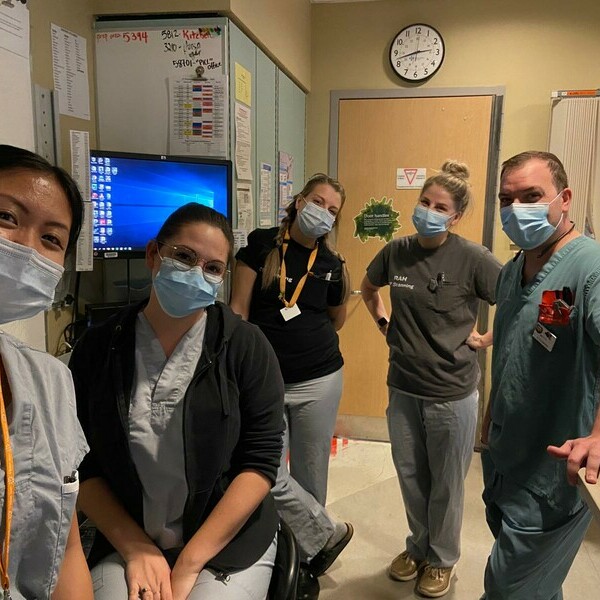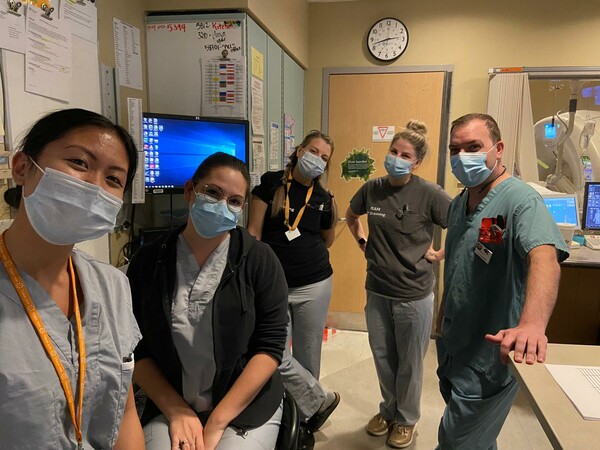Our Hospital, Our StoriesMRT Week: Supporting Canada’s Medical Radiation Technologists
Posted on: Nov 10, 2020Diagnostic Imaging is often the first department patients visit in order to gain info on their situation and identify the best path of treatment. MRT Week is a week to share appreciation for our Medical Radiation Technologists across the country.

In honour of MRT Week from November 8th-14th, we sat down with Dianne McMurray to better understand the department’s work and the importance of diagnostic imaging for better health care.
Dianne is the Director of the Diagnostic Imaging (DI) department for not just the Royal Alexandra Hospital, but also the Glenrose Rehabilitation Hospital and East Edmonton Health Centre.
“People come to us to find out if something is wrong with them. It can be quite scary. We sometimes forget that diagnostic imaging can also give us hope.” - Dianne McMurray, Director of Diagnostic Imaging
How large is the Royal Alex's Diagnostic Imaging department?
We have 121 MRTs that perform imaging in X-Ray, CT, Nuclear Medicine, MRI, Interventional Radiography and in the Cardiac Cath Labs. The MRTs work as a team with radiologists, sonographers, nurses, LPNs, porters, bio-medical, and clerical staff.
Last year, our DI department did 222,087 exams.
What areas does the department cover?
In addition to the RAH and Edmonton outpatients, our department supports the Sturgeon, Strathcona, Fort Saskatchewan, NEHC, and Glenrose Hospital for services they are unable to provide.
Our CT department does the most CT biopsies and cardiac scans in the Edmonton Zone, and the RAH MRI is the only department in Edmonton that does fetal imaging and non-contrast peripheral imaging. We also do the most MRI breast and prostate imaging in the zone.
What role does diagnostic imaging play in the wider scheme of healthcare?
Diagnostic imaging plays a critical role in the diagnosis, treatment and follow-up of health issues. Early diagnosis saves lives, and accurate medical decision-making can reduce unnecessary procedures.
Almost half (46.5%) of emergency visits at the Royal Alex require diagnostic imaging, that's more than 36,000 scans per year for our Emergency Department alone!
Can you share a bit more about your personal experience with the need for high-quality diagnostic imaging?
We all have loved ones who have gone through an experience with their health. My mother had lung cancer. From the time of diagnosis, chemotherapy, surgery and follow up she had X-rays, CT, MRI, CT-biopsies and bone scans. She did quite well afterwards and had some more years to enjoy the things she loved. She eventually started to take a downturn again. The worst fear is that the cancer was back and that she would not be able to physically manage treatment again. This took a huge emotional toll on her. By the time she was able to get a PET scan, she passed away the next day. The PET scan showed it wasn’t cancer at the cause of her issues. We sometimes forget that diagnostic imaging can also give us hope.
What do patients appreciate most about the DI department?
To be honest, the patients are most appreciative of our staff. People come to us to find out if something is wrong with them. It can be quite scary. Our staff are highly trained experts in their fields and use very intimidating equipment. The trust that the staff are able to gain from patients in such a short period of time speaks to their caring nature and professionalism.
What does MRT Week mean to you and why is it important?
MRT Week is a chance to recognize and celebrate the professionals who perform imaging. These are highly skilled people who are dedicated to imaging excellence and patient safety.
X-Ray, CT, MRI and Nuclear Medicine each have their advantages to give a picture of what is going on inside the body. An MRT specializes in one of those areas. Supporting our MRTs is always important, but they are under additional strain as frontline workers during this COVID-19 pandemic.
How has the department evolved its approach to imaging and healthcare in recent times?
Thanks to donors to the Royal Alexandra Hospital Foundation, we are thrilled and so proud to have a PET (Positron Emission Tomography) scanner at the Royal Alex!
PET scans are widely used in cancer imaging and the need for them is extremely high. This type of scanning is also used in neurology, inflammation imaging and cardiology. Worldwide there are new tracers that have been developed that, without this camera, we would not have access to. It is very exciting for so many reasons.
What do you think our staff, donors and constituents might appreciate most about the department?
I like to refer to the Royal Alex DI department as the “can-do” department in the “can-do” hospital. Our team focuses on doing what is best for our patients no matter what it takes. It takes ingenuity and grit to accomplish this. It’s an amazing team.
Is there anything else you'd like readers to know about the DI department and the people who work there?
There is nothing routine about diagnostic imaging. Every patient is treated as an individual and every scan and treatment is adjusted to be the best for that person.
Thank you to Dianne for sharing her expertise and story, and everyone in the DI department for the amazing work they perform every single day!
If you would like to support the Royal Alexandra's Diagnostic Imaging department, please consider a gift.
